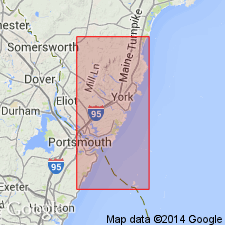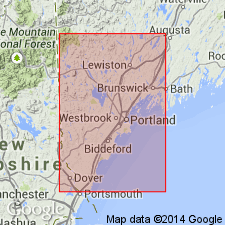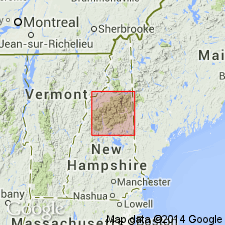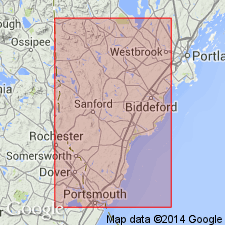
- Usage in publication:
-
- Agamenticus complex
- Modifications:
-
- Original reference
- Dominant lithology:
-
- Granite
- Syenite
- AAPG geologic province:
-
- New England province
Summary:
Pg. 149, 152-154. Agamenticus complex. Chiefly biotite granite (dominant phase), alkaline granite, and syenite, also the small stock of Berwick quartz diorite (apparently later than main biotite granite), and other small bodies, such as those along south side of York Harbor [see York Harbor biotite granite] and along northeast side of Brave Boat Harbor [see Brave Boat Harbor granite]. Three of the dominant rock types occur on slopes of Mount Agamenticus, York County, southwestern Maine. Assigned to Devonian(?).
Source: US geologic names lexicon (USGS Bull. 896, p. 16).

- Usage in publication:
-
- Agamenticus Complex
- Modifications:
-
- Age modified
- Geochronologic dating
- AAPG geologic province:
-
- New England province
Summary:
Age of Agamenticus Complex changed to Early Jurassic based on fission track of 172 Ma.
Source: GNU records (USGS DDS-6; Reston GNULEX).

- Usage in publication:
-
- Agamenticus pluton*
- Modifications:
-
- Revised
- AAPG geologic province:
-
- New England province
Summary:
Used informally as Agamenticus pluton of White Mountain Plutonic-Volcanic Suite.
Source: GNU records (USGS DDS-6; Reston GNULEX).

- Usage in publication:
-
- Agamenticus Complex
- Modifications:
-
- Areal extent
- Age modified
- AAPG geologic province:
-
- New England province
Summary:
Triassic Agamenticus Complex is earliest phase of subalkalic to alkalic magmatism associated with opening of Atlantic Ocean during the Mesozoic. Occurs in southwestern ME in townships of York, Wells, and South Berwick. Intrudes Precambrian to Ordovician Kittery and Eliot Formations of the Merrimack Group and the Devonian Webhannet Pluton. Late Triassic age based on 216-228 Ma dates of Foland and Faul (1977), Foland and others (1971), and Hoefs (1967). Complex has been recently mapped as part of ongoing research on the White Mountain Plutonic Series in southwestern ME. Four major lithologies discerned (from oldest to youngest): alkalic granite to quartz syenite, porphyritic biotite-amphibole granite, alkalic syenite, and a "contaminant zone" (Hussey, 1962) that is here renamed "syenite to quartz syenite" unit.
Source: GNU records (USGS DDS-6; Reston GNULEX).
For more information, please contact Nancy Stamm, Geologic Names Committee Secretary.
Asterisk (*) indicates published by U.S. Geological Survey authors.
"No current usage" (†) implies that a name has been abandoned or has fallen into disuse. Former usage and, if known, replacement name given in parentheses ( ).
Slash (/) indicates name conflicts with nomenclatural guidelines (CSN, 1933; ACSN, 1961, 1970; NACSN, 1983, 2005, 2021). May be explained within brackets ([ ]).

